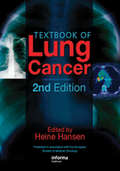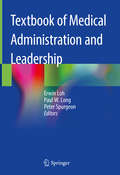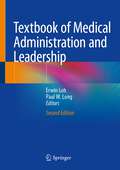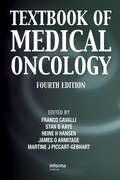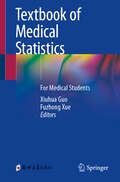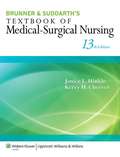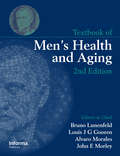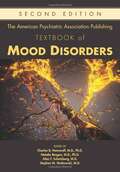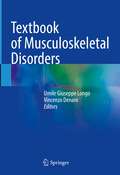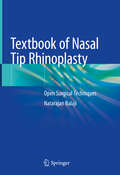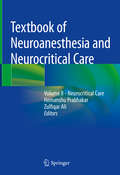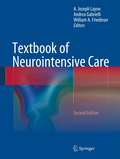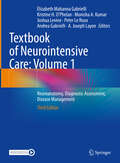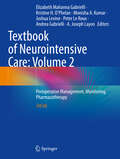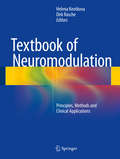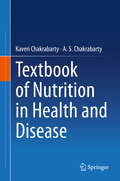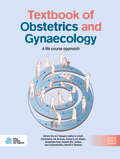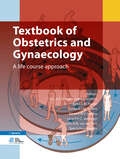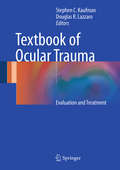- Table View
- List View
Textbook of Lung Cancer
by Heine Hansen MD FRCPTextbook of Lung Cancer, 2nd edition, published in association with the European Society of Medical Oncology, is a comprehensive and multidisciplinary text, which examines all aspects of this disease, with contributions from a multinational team of authors on etiology, epidemiology, molecular biology, pathology, smoking, detection and manage
Textbook of Male Genitourethral Reconstruction
by Tobias S. Köhler Francisco E. Martins Sanjay B. KulkarniThis textbook provides a guide to reconstructive surgery of genitourethral problems in male patients. The first section covers all aspects of urethral reconstruction, including the functional anatomy of the urethra, etiology, epidemiology, and demographic differences in urethral pathology. The second section focuses on surgical reconstruction of penile and scrotal anomalies and dysfunctions. Textbook of Male Genitourethral Reconstruction aims to aid the management of male genitourethral reconstruction patients by reviewing the recent advancements in technology and surgical technique. This book is relevant to urologists, plastic and reconstructive surgeons, medical students, and health care professionals working within urology and plastic surgery.
Textbook of Medical Administration and Leadership
by Erwin Loh Paul W. Long Peter SpurgeonThis textbook covers all general areas of knowledge required for a trainee, generalist medical administrator, and doctor undergoing training to be a medical administrator specialist. Chapters cover all the key topics on medical administration and leadership. Some of the key topics included are: health systems and policy, health law, private health and insurance, health disaster planning, population and public health, health information and technology, and health economics and financial management. Medical practitioners of today are part of huge changes in medical practice as continuing developments are happening in biomedical sciences and clinical practice with new health priorities, rising expectations among patients and the public, and changing societal attitudes. Consequently, basic knowledge and skills, while fundamentally important are not enough today on their own and doctors thus need to demonstrate leadership combined with sound management skills to drive the necessary changes required to meet the challenges head. This book serve as an invaluable resource for a wide spectrum of physicians including specialists, clinician managers and other health professionals, as well as non-clinical managers working in health. This is a gateway text for trainees in medical administration, specialist medical administrators, aspiring medical managers, health service managers, and heads of service and departments in various medical specialties.
Textbook of Medical Administration and Leadership
by Erwin Loh Paul W. LongThis textbook covers all general areas of knowledge required for a trainee, generalist medical administrator, and doctor undergoing training to be a medical administrator specialist. Chapters cover all the key topics on medical administration and leadership. Some of the key topics included are: health systems and policy, health law, private health and insurance, health disaster planning, population and public health, health information and technology, and health economics and financial management.Medical practitioners of today are part of huge changes in medical practice as continuing developments are happening in biomedical sciences and clinical practice with new health priorities, rising expectations among patients and the public, and changing societal attitudes. Consequently, basic knowledge and skills, while fundamentally important are not enough today on their own and doctors thus need to demonstrate leadership combined with sound management skills to drive the necessary changes required to meet the challenges head. This book serve as an invaluable resource for a wide spectrum of physicians including specialists, clinician managers and other health professionals, as well as non-clinical managers working in health. This is a gateway text for trainees in medical administration, specialist medical administrators, aspiring medical managers, health service managers, and heads of service and departments in various medical specialties.
Textbook of Medical Oncology
by Franco Cavalli James O. Armitage Heine H. Hansen Stan B. Kaye Martine J. Piccart-GebhartEffective care of the cancer patient increasingly involves systemic treatment, and as the range of available therapeutic agents continues to expand, the medical oncologist must be fully aware of the rationale for choosing specific drugs and combinations. Textbook of Medical Oncology, 4th edition, is written by a highly acclaimed list of internation
Textbook of Medical Statistics: For Medical Students
by Xiuhua Guo Fuzhong XueThis book introduces basic concepts, principle, and methods of medical statistics systematically and practically, especially in the statistical design of the experiment in terms of the specific problems, adequate use of statistical methods based on actual data and the reasonable explanation for statistical results.This textbook combines statistical methods with the common application of SPSS software, which is flexible, convenient, and user-friendly; thus, students can focus on the deep understanding of statistics.The authors emphasize the application and generalization of statistical methods, and combine these methods with the modern statistical theory, such as sequential contingency table and multivariate statistical modelling, etc.This book is a useful textbook for graduate and undergraduate students in medical schools, including MBBS (Bachelor of Medicine and Bachelor of Surgery) student.
Textbook of Medical-Surgical Nursing (Thirteenth Edition)
by Janice L. Hinkle Kerry H. CheeverPrepare for medical-surgical nursing practice and success on the NCLEX with Brunner & Suddarth's Textbook of Medical-Surgical Nursing, 13th Edition. A favorite resource for students and practicing nurses for almost a half-century, this book provides comprehensive yet accessible coverage of a broad range of medical conditions while focusing on the nursing process and the nurse's role in caring for and educating patients and families within today's complex health care delivery system. Up-to-date coverage of the health care needs of people with disabilities, nursing research findings, ethical considerations, and evidence-based practice gives you opportunities to refine your clinical decision-making skills. Fully updated and enhanced, this new edition provides a fully integrated solution that promotes clinical judgment, performance, and success on the NCLEX examination and in nursing practice. Key Features in the 13th Edition: NEW! Concept Mastery Alerts clarify difficult concepts, informed by data from Misconception Alert questions in PrepU for Brunner & Suddarth's Textbook of Medical-Surgical Nursing, 12e. NEW! Quality and Safety Nursing Alerts build upon previous edition's Nursing Alerts to highlight issues related to quality and safety nursing care. NEW! The updated unit openers include new Case Studies with QSEN Competency Focus to highlight a competency and related knowledge, skills, and attitudes. Additional information for these case studies related to NANDA-I, NIC, NOC and the nursing process is available online. NEW! Prioritization Questions have been added to the Critical Thinking Exercises. UPDATED! Genetics Charts and Ethical Dilemma Charts have been revised to reflect the latest advances in the field. UPDATED! Critical care information has been updated to further the authors' goal to have the most up-to-date and clinically relevant content on critical care throughout the book. EXPANDED! Expanded coverage of obesity, highlighted with a new icon, focuses on this epidemic health problem in our society. STEAMLINED! The Table of Contents has been reorganized for a more logical sequence and flow. REVISED! The accompanying Study Guide now features reorganized content and revised questions. Nursing Process sections, Plans of Nursing Care, and Critical Care sections More than 2,900 NCLEX-style review questions Assessment Charts, Risk Factor Charts, Guidelines Charts, Genetics in Nursing Practice Charts, Patient Education Charts, Health Promotion Charts, Ethics and Related Issues Charts, and Pharmacology Charts and tables. Gerontologic Considerations sections, Physiology/Pathophysiology figures, and Home Care Checklists Nursing Research Profiles and EBP questions help students learn the importance of evidence-based practice. Concepts in Action Animations bring anatomy, physiology and pathophysiology concepts to life.
Textbook of Men's Health and Aging
by Bruno Lunenfeld Louis Jg Gooren Alvaro Morales John E MorleyThe first edition of "Textbook of Men's Health" did much to establish and define the scope of the emerging subspecialty of aging men's health. This revised and updated edition, with new sections on basic sciences and sexual dysfunction, has a small but significant change of approach - reflected in the new title. The central mission of the new editi
Textbook of Microbiology and Immunology
by Subhash Chandra ParijaThe fourth edition of “Textbook of Microbiology and Immunology” is an extensively revised edition , a healthy mixture of the old and the new contents. Many of the old traditional chapters have been retained with addition of new information along with the inclusion of new chapters more in line with the on-going changes in the syllabus and concepts in Medical Microbiology .While doing so, this book has blended the traditional organism-based learning and a syndrome based approach to infectious disease, together with the introduction of new and modified chapters incorporating the latest information in this field.The book provides an extensive coverage of fundamental topics in general and medical microbiology. The book also lays due emphasis on clinical microbiology with special focus on syndrome based approach to infectious diseases. It includes the basic concepts of microbiology as well as the recent updates and developments in the field of medical microbiology. All the topics have been incorporated in seven major sections: General microbiology, Immunology, Bacteriology, Virology, Mycology, and Applied and Clinical Microbiology.The dynamic nature of medical sciences with new guidelines and new diagnostic methods coming into the arena necessitates the incorporation of new information in each new edition of a book. This facet has been addressed with the inclusion of recent information on the various aspects of microbiology, infectious diseases and immunology, in the fourth edition of the Textbook of Microbiology and Immunology ,which makes it one of the most authoritative and informative textbooks in medical microbiology.The book is an effort to inform and engage a wide spectrum of readers including medical students , both undergraduates and postgraduates, and residents, and faculty. It aims to be a must-have companion book for graduate and advanced undergraduate as well as postgraduate students of medical microbiology, general and allied microbiology, and of immunology.
Textbook of Mood Disorders
by Schatzberg NemeroffThis new edition of The American Psychiatric Association Publishing Textbook of Mood Disorders is a systematic and painstaking reconceptualization of its predecessor. Under new editorial direction and with a revised roster of expert contributors, the second edition is an utterly current, clinically competent, and comprehensive text that will become an instant classic. The book is structured for learning and easy reference, moving deftly from symptomatology and epidemiology to pathogenesis and on to somatic interventions, cognitive-behavioral interventions, and psychotherapy. The latest science on genetics and epigenetics, brain imaging, and neurobiology are also examined in depth. Critically important to the clinician is the section on management of mood disorders, which provides treatment guidelines for major depressive disorder and bipolar disorder, as well as information on understanding, and preventing, suicide in children, adolescents, and adults. Finally, perspectives are offered on depression among women, children, and geriatric patients, as well as on depression across cultures. Practicing psychiatrists, residents, and students alike will benefit from the book's inclusive coverage. Topics new to this edition include the following: - Treatment-resistant depression--its definition and approaches to its treatment--is addressed in a dedicated chapter that covers diagnostic accuracy, pseudoresistance, comorbidity, pharmacological management, adjunctive strategies, psychotherapy, neuromodulation, and novel and experimental therapies.- Investigational agents, most notably ketamine and its relatives, constitute an exciting frontier in the treatment of mood disorders, and the clinical application, routes of delivery, dosing, risks, and clinical trials are explored in a dedicated chapter that is both rigorous and thorough.- There is compelling evidence that childhood maltreatment (defined as exposure to emotional, physical, and sexual abuse and neglect before the age of 18 years) is a prominent risk factor for the development of mood disorders as well as for a pernicious course and poor treatment response in mood disorders. These findings, as well as the underlying neurobiological and environmental interactions that may contribute to the development of mood disorders, are examined thoroughly and thoughtfully.- As our understanding of immune function in mood disorders has grown, psychoneuroimmunology has emerged as a focus of study likely to make major contributions to clinical practice in the coming decades. The book updates readers on this promising area of research. Over the last decade, depression has emerged as the leading cause of disability worldwide, with significant attendant morbidity and mortality. The American Psychiatric Association Publishing Textbook of Mood Disorders equips clinicians and trainees with the knowledge they need to alleviate suffering in their patients with mood disorders.
Textbook of Musculoskeletal Disorders
by Vincenzo Denaro Umile Giuseppe LongoThis textbook presents the full spectrum of musculoskeletal disorders, covering their definitions, epidemiology, physiopathology, diagnosis and treatment. Ranging from fractures, through infections and tumors, to dystrophies, the authors provide an up-to-date overview of the methodologies used in the diagnosis and management of common orthopedic conditions.The content is divided into several sections: disorders are grouped by typology in the opening section, and subsequently grouped anatomically, offering readers a quick and convenient reference guide to fundamental concepts in everyday orthopedic care.Written by an international panel of experts, it offers a valuable asset for students and residents approaching the study of orthopedics, pediatric orthopedics, sports medicine, rheumatology and rehabilitation. It further can be of interest also for practicing orthopedic surgeons, as well as nurses, physical therapists and athletic trainers.
Textbook of Nasal Tip Rhinoplasty: Open Surgical Techniques
by Natarajan BalajiThis textbook addresses the growing need for a manual that teaches when and how to perform nasal tip rhinoplasty through an “Open-Approach”. Practitioners will value the comprehensive coverage of the topic.The actual surgical steps involved in the various techniques form the main body of the work, while a wealth of intra-operative photographs facilitate the learning experience. The views expressed are solely those of the author, based on his personal experience. He makes no claims to the content being exhaustive or the only possible approach and has extensively referenced various experts in the field who have contributed to this topic. This book represents the author’s view of how to approach nasal tip deformities, and how to arrive at an algorithm in putting together various surgical techniques in a “sequence” to achieve meaningful results. The book also explores the clinical correlation, which is just as or arguably even more important in nasal tip surgery. The main chapters will focus on the suture, grafting, non-suture and non-grafting techniques in nasal tip reconstruction.Drawing on the author’s surgical experience, gathered in the course of over 1700 open tip surgeries over 23 years, the book fills a lacuna in teaching and training and will be of interest to all trainees and consultant surgeons seeking concise information on nasal tip surgery.
Textbook of Neural Repair and Rehabilitation
by Robert H. Miller Michael E. Selzer Stephanie Clarke Leonardo G. Cohen Gert Kwakkel Michael E. Selzer Stephanie Clarke Leonardo G. Cohen Gert KwakkelIn two freestanding volumes, Textbook of Neural Repair and Rehabilitation provides comprehensive coverage of the science and practice of neurological rehabilitation. Revised throughout, bringing the book fully up to date, this volume, Medical Neurorehabilitation, can stand alone as a clinical handbook for neurorehabilitation. It covers the practical applications of the basic science principles presented in Volume 1, provides authoritative guidelines on the management of disabling symptoms, and describes comprehensive rehabilitation approaches for the major categories of disabling neurological disorders. New chapters have been added covering genetics in neurorehabilitation, the rehabilitation team and the economics of neurological rehabilitation, and brain stimulation, along with numerous others. Emphasizing the integration of basic and clinical knowledge, this book and its companion are edited and written by leading international authorities. Together they are an essential resource for neuroscientists and provide a foundation of the work of clinical neurorehabilitation professionals.
Textbook of Neural Repair and Rehabilitation
by Robert H. Miller Michael E. Selzer Stephanie Clarke Leonardo G. Cohen Gert Kwakkel Michael E. Selzer Stephanie Clarke Leonardo G. Cohen Gert KwakkelIn two freestanding volumes, Textbook of Neural Repair and Rehabilitation provides comprehensive coverage of the science and practice of neurological rehabilitation. Revised throughout, bringing the book fully up to date, this volume, Medical Neurorehabilitation, can stand alone as a clinical handbook for neurorehabilitation. It covers the practical applications of the basic science principles presented in Volume 1, provides authoritative guidelines on the management of disabling symptoms, and describes comprehensive rehabilitation approaches for the major categories of disabling neurological disorders. New chapters have been added covering genetics in neurorehabilitation, the rehabilitation team and the economics of neurological rehabilitation, and brain stimulation, along with numerous others. Emphasizing the integration of basic and clinical knowledge, this book and its companion are edited and written by leading international authorities. Together they are an essential resource for neuroscientists and provide a foundation of the work of clinical neurorehabilitation professionals.
Textbook of Neuroanesthesia and Neurocritical Care: Volume II - Neurocritical Care
by Hemanshu Prabhakar Zulfiqar AliThis two-volume book offers a comprehensive guide to anesthetic management and critical care management in neurosurgical and neurological patients. This second volume focuses on neurocritical care. The book begins with basic information on the principles of neurocritical care. Management of various neurological problems such as myasthenia gravis, Guillain-Barré syndrome, epilepsy, stroke and many more are discussed in detail. Subsequent sections address nursing care, physiotherapy and psychological care, issues related to brain death and organ donation, and common complications observed in neurological patients during their ICS stays. Each complication is discussed in detail, guiding readers in their clinical practice. In turn, the book’s closing chapters cover e.g. the role of hypothermia and evidence-based practice. The book offers a valuable resource for all residents, fellows and trainees in the fields of neurointensive care and critical care; it will also benefit intensivists and neurocritical care experts.
Textbook of Neurointensive Care
by William A. Friedman A. Joseph Layon Andrea GabrielliThis updated and refined new edition is the only book to provide a comprehensive approach to the intensive care of neurologically injured patients from the emergency room and ICU through the operating room and post-surgical period. It reviews neuroanatomy, neuroradiology, and neurophysiology, examines the neurological problems most frequently seen in intensive care, and describes the various types of neurosurgery. General issues are discussed, such as cardiac care, fluids and electrolytes, nutrition, and monitoring as well as more specific conditions and complications including elevated intracranial pressure, seizures, and altered mental states.
Textbook of Neurointensive Care: Neuroanatomy, Diagnostic Assessment, Disease Management
by Joshua Levine A. Joseph Layon Andrea Gabrielli Elizabeth Mahanna Gabrielli Kristine H. O’Phelan Monisha A. Kumar Peter Le RouxThis extensively updated edition provides a comprehensive review of intensive care for neurologically injured patients from the emergency room and ICU through the operating room and post-surgical period in two comprehensive volumes. The Editors of this first volume present a comprehensive textbook that incorporates best practice/evidence-based medicine and performance improvement, while it champions the three characteristics needed in our neuro–ICUs: patient and family centered high-quality care, education, and discovery. This volume concentrates on neuroanatomy, diagnostic assessment and disease management, examining the neurological problems most frequently seen in intensive care, and describes the various types of neurosurgery and critical features of the management of patients. General issues are discussed across the textbook, such as cardiac care, fluids and electrolytes, nutrition, and monitoring as well as more specific conditions and complications including elevated intracranial pressure, seizures, and altered mental states. Listening to an injured brain is not easy. It takes knowledge, dedication, and understanding of the critically ill patient and their family. Textbook of Neurointensive Care Volume 1: Neuroanatomy, Diagnostic Assessment, Disease Management provides the reader with a detailed resource for studying this most complex area of medicine. It is thus essential reading for all trainees and professionals in critical care, neurosurgery, anesthesia and neurology.
Textbook of Neurointensive Care: Perioperative Management, Monitoring, Pharmacotherapy
by Joshua Levine A. Joseph Layon Andrea Gabrielli Elizabeth Mahanna Gabrielli Kristine H. O’Phelan Monisha A. Kumar Peter Le RouxThis extensively updated edition provides a comprehensive review of intensive care for neurologically injured patients from the emergency room and ICU through the operating room and post-surgical period in two comprehensive volumes. The Editors of this second volume present a comprehensive textbook that incorporates best practice/evidence-based medicine and performance improvement, while it champions the three characteristics needed in our neuro–ICUs: patient and family centered high-quality care, education, and discovery. This volume concentrates on perioperative management, monitoring and pharmacotherapy, examining the neurological problems most frequently seen in intensive care, and describes the various types of neurosurgery and critical features of the management of patients. General issues are discussed across the textbook, such as cardiac care, fluids and electrolytes, nutrition, and monitoring as well as more specific conditions and complications including elevated intracranial pressure, seizures, and altered mental states. Listening to an injured brain is not easy. It takes knowledge, dedication, and understanding of the critically ill patient and their family. Textbook of Neurointensive Care Volume 2: Perioperative Management, Monitoring, Pharmacotherapy provides the reader with a detailed resource for studying this most complex area of medicine. It is thus essential reading for all trainees and professionals in critical care, neurosurgery, anesthesia and neurology.
Textbook of Neuromodulation
by Helena Knotkova Dirk RascheUntil recently, it was thought that the adult brain is modifiable only during early stages of ontogenesis. However, neurophysiological and neuroimaging studies now indicate that the mature human brain is, under certain conditions, capable of substantial neuroplastic changes. Neuroplasticity reflects the ability of the human brain to alter the pattern of neural activation in response to previous experience, and recent findings indicate that the effects of experience can lead to both structural as well as functional reorganization. It has been shown that pathological neuroplastic changes can be reverted/normalized and that the modulation of the neuroplastic changes can be paralleled by improvement of the patient's status. However, there is a gap between the potential of neuromodulation, technical progress and actual preparedness of medical personnel to provide this type of treatment. A prevalent opinion among medical professionals indicates that training programs and educational materials in neuromodulatory techniques are well needed and appreciated. Neuromodulation will focus on the description and discussion of methods currently available for invasive and non-invasive neuromodulation, their clinical potential, significance and practical applications. In order to facilitate understanding of the topic, the initial part of the textbook will review neurophysiological systems involved in neuromodulation and will provide readers with basic principles of neuroplasticity that constitutes the rationale for neuromodulation in human medicine. Additionally, the clinical use of these techniques will be described with special regard to safety and avoidance of complications.
Textbook of Nutrition in Health and Disease
by Kaveri Chakrabarty A. S. ChakrabartyThis textbook offers a concise, yet comprehensive account of human nutrition, food and nutrition-related health problems, based on the curricula of top universities around the globe. Nutrition is a multidisciplinary science, and as such, the book discusses various aspects of physiology, biochemistry, pathology, immunology, medicine, food science, and other fields related to nutrition, it focuses on the role of nutrition in the maintenance of health. The various chapters explore highly relevant issues, such as, addiction-related health problems, lifestyle-related disorders, social health problems and poor-maintenance of food hygiene and food safety. It also addresses the role of nutritional therapies for mental disorders, and includes an integrated perspective on cognition, oxidative stress and nutritional interventions in aging. Other topics include, the role of gut microbiota on human health, nutraceuticals as therapeutic agents and ketogenic diets. It also highlights malnutrition (protein energy malnutrition, starvation, malabsorption syndrome, eating disorders and overnutrition/obesity) and adipose tissue as an active endocrine organ. Moreover, it examines key concepts concerning the role of vitamins in the citric acid cycle (gluconeogenesis, ketogenesis, oxidative deamination and transamination) and precursors of coenzymes, as well as calorigenic hormones, appetite-stimulating/appetite-inhibiting hormones, anabolic and catabolic hormones affecting protein metabolism, and lipogenetic/lipolytic hormones.
Textbook of Nutritional Biochemistry
by Darshan Malik Nandita Narayanasamy V A Pratyusha Jayita Thakur Nimisha SinhaThis textbook for undergraduate students aims at providing an in-depth understanding of the relationship between diet, nutrients, health, diseases, and drug treatment. The book presents a comprehensive but detailed view of the field of Nutritional Biochemistry; balancing the historical with contemporary findings, the descriptive with the experimental, structure with function as well as the mechanistic and the clinical aspects of any particular nutrient. Though the major emphasis of the book is on Nutritional Biochemistry, the book also attempts to provide an insight into other related and relevant areas. Amongst the topics that are covered are: nutraceuticals, food, and nutrient interactions; the newly emerging field of the human microbiome, its interdependence on diet and human health as well as the public health concerns which is a looming burden of non-communicable diseases. Each chapter begins with an insight into the history of discovery and structure of the nutrient, its absorption, and metabolism, physiological functions, ending with diseases associated with nutrient deficiency/toxicity along with a clinical perspective. Apart from this, the book emphasizes the biochemical basis of physiological responses and correlates the same with symptoms identifying the pathophysiology. This textbook caters to students of undergraduate courses like Biochemistry, Biomedical Sciences, Biological Sciences, Life Sciences, Home Science; Nutrition and Dietetics, Clinical Nutrition and Dietetics, and Nursing.
Textbook of Obstetrics and Gynaecology: A life course approach
by Eric A.P. Steegers Carina G.J.M. Hilders Vincent W.V. Jaddoe Sam Schoenmakers Christianne J.M. de Groot Annemieke Hoek Ronald P. ZweemerIn this textbook the life course approach to women's health is applied to the clinical practice of Obstetrics and Gynaecology. Life is considered a continuum ‘from the cradle to the grave’, where each life stage affects the individual's health and wellbeing and that of future generations. This approach in obstetric and gynaecological patient care provides a path towards healthy ageing, with specific attention for lifestyle, prevention and social context. By managing not only disease, but also the health of the population, women's healthcare providers will deliver future care in a much more multidisciplinary fashion. In this second edition of Textbook of Obstetrics and Gynaecology: A life course approach all texts have been updated and new chapters have been added on transgender care, multiple pregnancy, clinical placenta disorders, endometriosis and obstetric emergencies by an outstanding team of authors. The illustrative material has also been expanded including new introductory infographics to each life stage part of the book and new 3D video animations in the e-book version. The textbook should serve as a reference not only for medical and midwifery students but also for gynaecologists in training and other clinicians who have the privilege of caring for women and their families, from the earliest moments in life onwards.
Textbook of Obstetrics and Gynaecology: A life course approach
by Eric A.P. Steegers Bart C.J.M. Fauser Carina G.J.M. Hilders Vincent W.V. Jaddoe Leon F.A.G. Massuger Joris A.M. van der Post Sam SchoenmakersThe Textbook of Obstetrics and Gynaecology: a life course approach is the latest edition of the Dutch Textbook Obstetrie en Gynaecologie, de voortplanting van de mens, which has been the leading handbook in Dutch medical and midwifery schools since 1993. In this current edition, for the first time, a life course approach to women’s health is applied to the clinical practice of Obstetrics and Gynaecology. Life is considered a continuum ‘from the cradle to the grave’, where each life stage affects the individual’s health and wellbeing and that of future generations. This approach in obstetric and gynaecological patient care provides a path towards healthy ageing, with specific attention for lifestyle, prevention and social context. By managing not only disease, but also the health of the population, women’s healthcare providers will deliver future care in a much more multidisciplinary fashion.The textbook’s structure and content have been completely revised and rewritten according to the life course approach, and the volume has been considerably condensed by an outstanding team of authors. The illustrative material has also been renewed, and now includes 3D video animations and films of five surgical procedures in the e-book version. The textbook should serve as a reference not only for medical and midwifery students but also for gynaecologists in training and other clinicians who have the privilege of caring for women and their families, from the earliest moments in life onwards.
Textbook of Ocular Trauma
by Stephen C. Kaufman Douglas R. LazzaroArranged by ocular anatomy and subspecialty, with a detailed index permitting the reader to locate a discussion involving a specific type of ocular injury, this text covers ocular trauma in the pediatric and adult patient with medical and surgical treatment options, as well as potential complications. The Textbook of Ocular Trauma: Evaluation and Treatment provides a practical reference and educational resource for ophthalmologists, ophthalmology residents, emergency room physicians and residents, and pediatric physicians and residents, with basic and advanced instruction in the evaluation and management of eye and surrounding tissue trauma. This text includes multiple case reports with high quality color photographs after each section, as well as detailed medical illustrations of trauma cases and their treatment. Case studies include both common and unusual types of ocular and surrounding tissue trauma, which provide practical guidance in the evaluation and treatment of eye injuries.
Textbook of Onco-Anesthesiology
by Sushma Bhatnagar Rakesh GargThis book covers all essential evidence on perioperative care and anesthetic concerns for cancer surgeries, including the evaluation and assessment of patients’ schedule for cancer surgeries, perioperative anesthetic management of various cancers, perioperative analgesia for cancer surgeries, and issues related to inoperable cancers. It reviews anesthetic considerations of all cancer types as there is a wide variation in anesthetic requirements in this subset of patients. Cancer surgeries are on the rise worldwide and healthcare facilities with cancer as a core specialty are emerging quickly around the globe. As cancer is on rise and efficient surgical management is available, more and more patients are being treated surgically. However, cancer surgeries are complicated, have varied concerns and these are not covered sufficiently in presently available textbooks of anesthesiology. This book fulfills the growing need for complete and comprehensive textbook of onco-anesthesia and fills the gap in the current texts that do not exclusively cover anesthesia for cancer surgeries.This textbook serves as a comprehensive but quick guide for trainee residents/fellows and practicing anesthesiologists, clinicians and surgeons.
